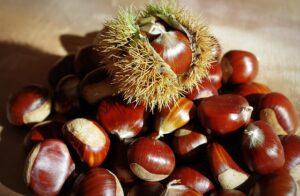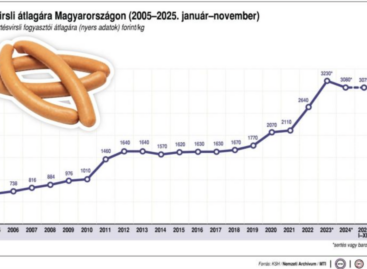Sweet chestnuts are a healthy delicacy when cooked, fried or processed
This year’s sweet chestnut harvest was less than usual. Not only in our country, but throughout Europe, less of the favorite delicacy of the autumn-winter period has been produced, but there is no need to fear a shortage – it was revealed in the joint overview of the National Chamber of Agriculture and the Hungarian Vegetable and Fruit Association (FruitVeB). The processed products favored by Hungarian consumers will continue to be available in stores, in addition to the classic chestnut puree, there are many other chestnut products to choose from. The consumption of fresh chestnuts could be increased in the future by a conscious selection of varieties.

(Photo: Pixabay)
Sweet chestnuts are particularly popular among domestic consumers. This fruit with a special flavor is a real vitamin bomb. Many people would not think so, but the vitamin C content of chestnuts is as high as that of raspberries and currants. In terms of its content, it contains only a very small amount of fat and no cholesterol at all. Thanks to its high carbohydrate content, it can replace cereals and potatoes in our diet. In addition to roasted chestnuts, which evoke the atmosphere of fairs, they are mostly sold to consumers in the form of dessert. In addition to the classic chestnut puree, consumers can now choose from a wide range of products, various creams, filled pastries, pre-cooked quick-frozen chestnuts, chestnut flour, as well as the truly special chestnut meatballs and scones. Unlike other fruits, chestnuts do not lose their vitamin content even in processed form. Traditional chestnut mass and puree also contain a significant amount of valuable vitamins.
According to the joint overview of the National Chamber of Agriculture and the Hungarian Fruit and Vegetable Association (FruitVeB), sweet chestnuts are grown on about 281 hectares in Hungary
Special ecological requirements must be met for growing the fruit, as it requires wetter weather, higher humidity and acidic soil. For this reason, only a few regions of the country are suitable for cultivation, so the plant is widespread in the growing regions of southern Transdanubia, western Transdanubia and the Börzsöny Mountains. The largest areas are cultivated in Vas and Somogy counties (75-72 hectares) and in Zala (60 hectares). Most chestnut trees are still scattered, so the national annual yield is typically between 150 and 300 tons. This year, the hot, dry summer was not favorable for chestnuts, so it was possible to harvest even less than usual. However, the scarcer crop results were typical of other regions of Europe in addition to our country this year. According to experts, there is no need to fear a shortage, but it is likely to be reflected in the price of finished products.
In our country, most consumers encounter chestnuts in a processed form, the fruit is also an excellent delicacy fresh – cooked or fried
At the same time, consumption is hindered by the fact that it is difficult to buy good quality fruit. While in most places abroad, customers can already choose chestnuts by variety, here, merchants typically do not indicate the variety of the fruit. Although there are very big differences between the taste and texture of each variety. The exterior often does not reveal the inner beauty, the consumer may be disappointed even when buying a shiny, large-eyed chestnut. By indicating the varieties, customer awareness could also be strengthened, since if a variety has already “worked” for someone, they will look for it again next time.
NAK
Related news
NAK: it’s worth buying Hungarian sausages on New Year’s Eve too
🎧 Hallgasd a cikket: Lejátszás Szünet Folytatás Leállítás Nyelv: Auto…
Read more >This year, 10 percent more new wine was produced than last year
🎧 Hallgasd a cikket: Lejátszás Szünet Folytatás Leállítás Nyelv: Auto…
Read more >More than 100 Hungarian farmers also demonstrated in Brussels
🎧 Hallgasd a cikket: Lejátszás Szünet Folytatás Leállítás Nyelv: Auto…
Read more >Related news
The GVH imposed fines of more than 3.7 billion forints on 29 companies in 2025
🎧 Hallgasd a cikket: Lejátszás Szünet Folytatás Leállítás Nyelv: Auto…
Read more >Hungary’s economy in 2025: recovery from slowdown, weaker forint and the increasing importance of corporate strategic decisions 2026 will be a test of resilience
🎧 Hallgasd a cikket: Lejátszás Szünet Folytatás Leállítás Nyelv: Auto…
Read more >NAK: it’s worth buying Hungarian sausages on New Year’s Eve too
🎧 Hallgasd a cikket: Lejátszás Szünet Folytatás Leállítás Nyelv: Auto…
Read more >





